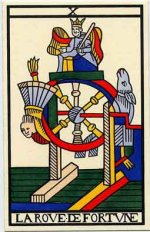Diana:
This is one of those cards whose elements changed over time, and as those elements were altered the original meaning was somewhat obscured. On the Visconti-Sforza card a blindfolded Dame Fortune herself sits in the middle of the wheel with her hands on the spokes, turning them. All the figures riding the wheel as well as the one who has fallen off are human. You can't see it on the card that's posted here, but they all have banners coming out of their mouths; the person at the top is saying "I reign," the one on the right says, "I have reigned," the one on the left, "I will reign," and the one who has fallen off at the bottom, "I am without reign." The reigning person has an ass's ears, indicating foolishness, because he (or she) is naive enough to think he has put himself on top, and will stay there permanently. This, and the fact that the banner of the person at the bottom almost goes into the shirt of the person on the left, so that it looks like a tail, are probably what caused later card makers to interpret the figures as animals, or maybe as part human and part animal.
The Cary-Yale card posted here follows the Visconti-Sforza's example, but it's not part of the original Cary-Yale deck. It's one of the replacement cards executed in 1983 by Luigi Scapini.
But the commentary is on the condition of humanity, and in answer to your question of whether we control our own lives, and determine our own destinies, I believe the originators of this card are answering "no." We're all forced to endure life's ups and downs, and fate, as well as luck, are random elements we can never escape. That's one of the reasons I think the wheel was such a popular icon in churches; it underscores the message that, "This is God's world, not ours."
Unfortunately, this is a prime example of the main elements of a card undergoing gradual changes, which in time become so extensive that the original meaning of the picture is supplanted by other, more esoteric interpretations.
(cb)


